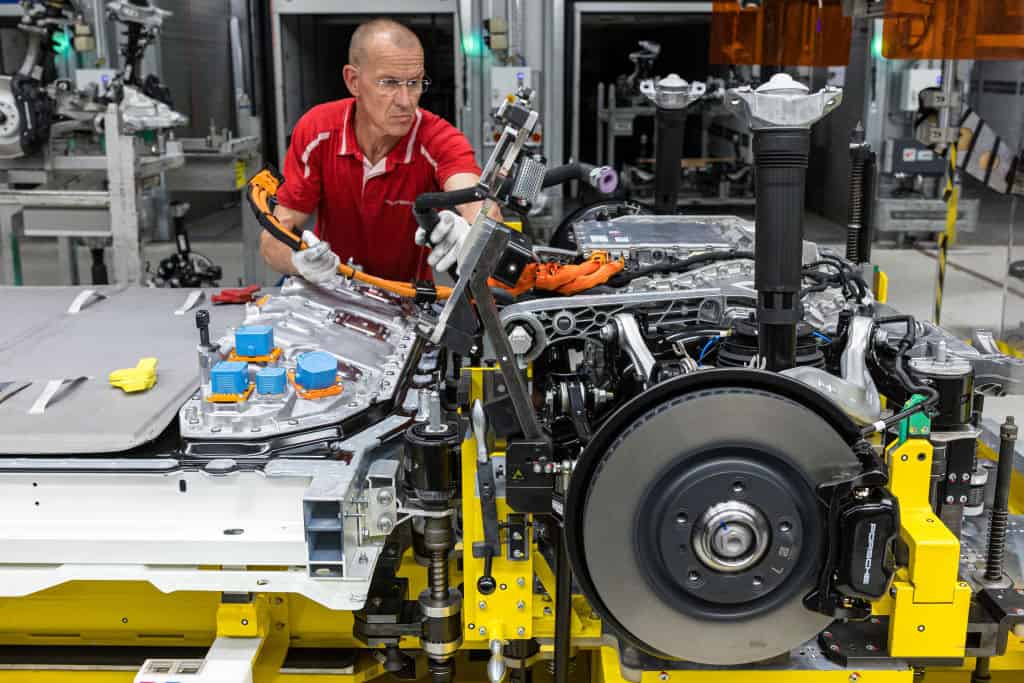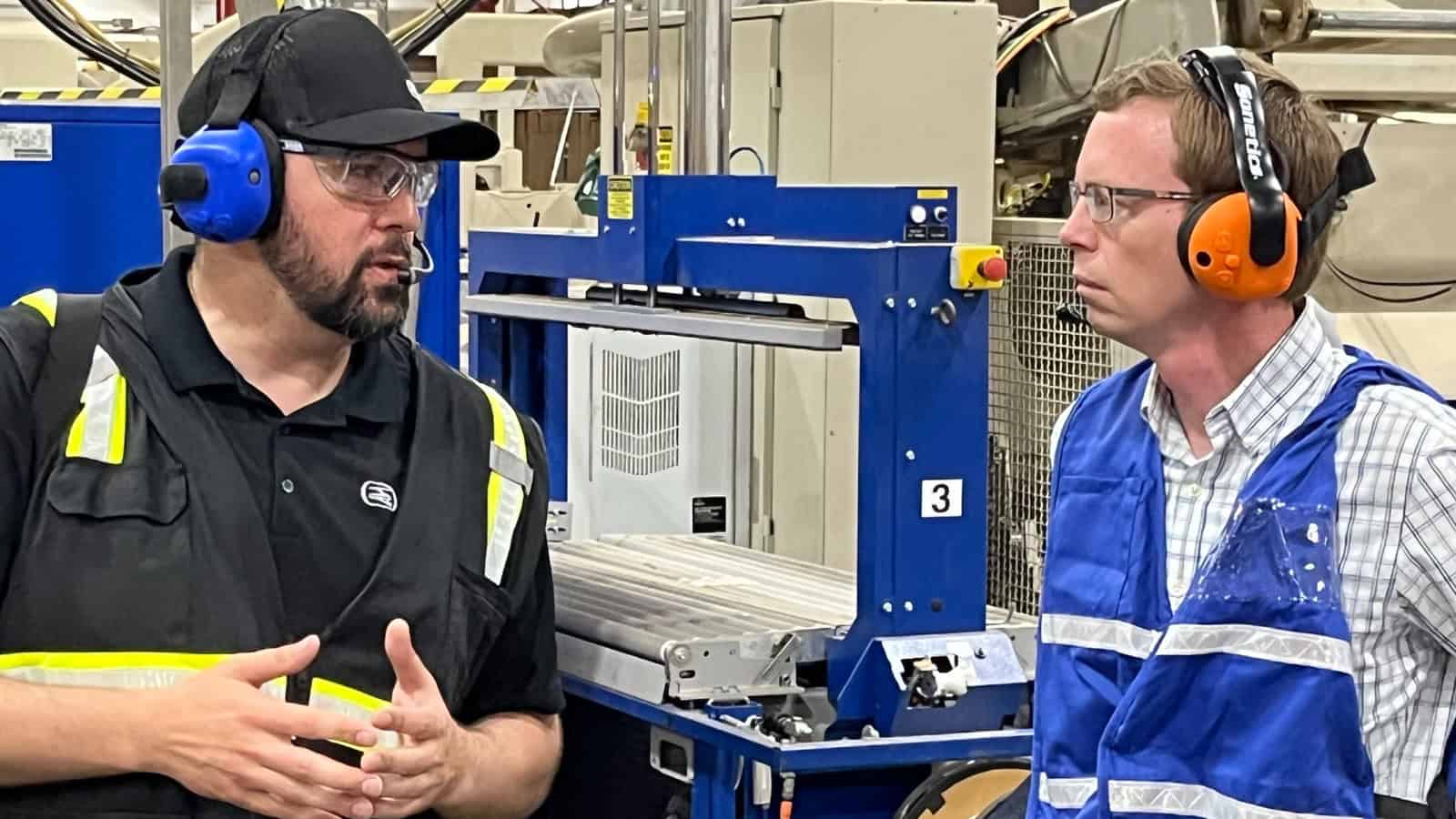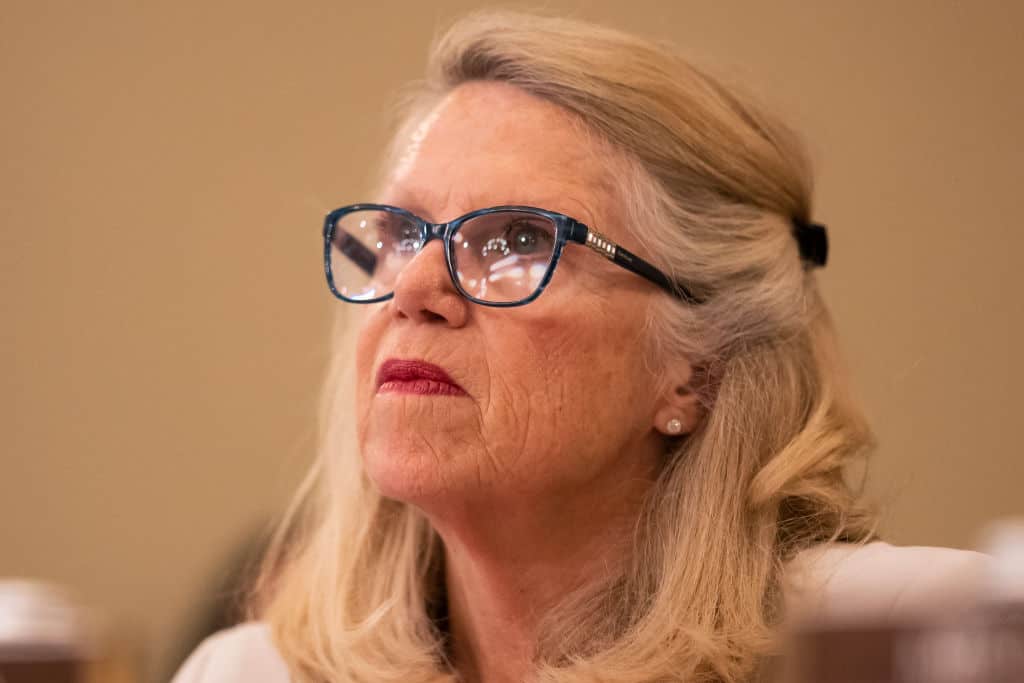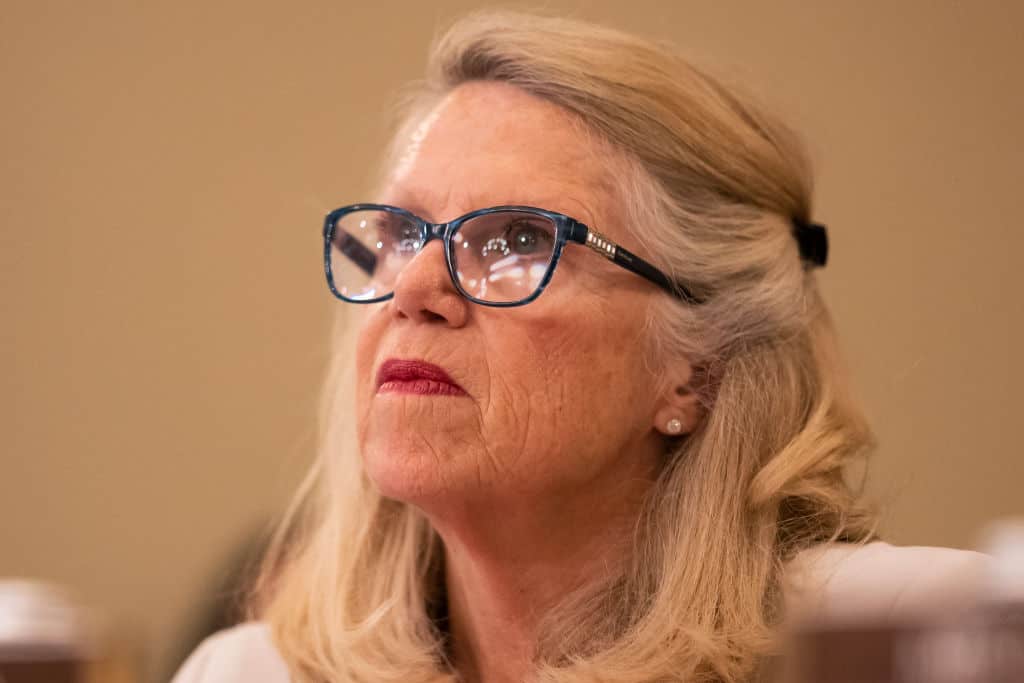Mexican Reforms Jeopardize U.S.–Mexico Trade

If enacted, the broad constitutional amendments being pushed by outgoing Mexican President Andrés Manuel López Obrador would put the special U.S.–Mexico trade relationship at serious risk, according to the NAM.
What’s going on: Last week, Obrador froze Mexico’s relationships with U.S. and Canadian embassies following concerns voiced by those countries’ ambassadors about the proposed reforms, which include sweeping changes to the Mexican judiciary and the elimination of several important state regulatory and oversight agencies.
- Mexico is America’s largest trading partner, with the volume of trade between the two nations coming in at $900 billion last year.
- Obrador’s proposed revisions led investment bank Morgan Stanley to issue an “effective ‘sell’ recommendation on Mexico” late last month (Reuters, subscription).
Why it’s a problem: “We’re concerned that some of the reforms as proposed could harm Mexico’s standing as an attractive place to do business,” NAM Vice President of International Policy Andrea Durkin said on the “Imagen Empresarial” (“Corporate Image”) podcast last week. “Manufacturers pay attention to how banks are factoring these potential changes to the constitution into Mexico’s risk profile.”
- Indeed, “[i]nvestors see independent judiciaries—sheltered from politics—as a sign of strong rule of law,” one emerging markets expert told The Wall Street Journal (subscription).
- Several planned revisions also appear to violate Mexico’s obligations under the U.S.–Mexico–Canada Agreement, which is due for review by all three nations in 2026. Moving forward with the reforms could jeopardize the continuation of that deal.
What’s next: Incoming Mexican President Claudia Sheinbaum, who takes office Oct. 1, “supports the judicial changes, but executing the overhaul might take up most of the energy of her new government, leaving her little bandwidth for her own agenda, which includes an expansion of social programs that need foreign investment,” according to the Journal.
Manufacturers: Resolution in Canadian Rail Dispute Avoids Critical Disruption to Supply Chains
Washington, D.C. – Following the Canada Industrial Relations Board’s decision ordering rail workers back to work and carriers back to operations, National Association of Manufacturers President and CEO Jay Timmons released the following statement:
“Manufacturers in the U.S. and in Canada were rightly concerned about the serious impact of a work stoppage that would harm workers, the economy and the quality of life for the many millions who depend on our products. As I discussed with Prime Minister Trudeau in July, if rail traffic were to grind to a halt, workers, small businesses and communities on both sides of our border would be hardest hit. Thankfully, the prime minister and Minister of Labour and Seniors Stephen MacKinnon heard our concerns and took decisive action to avert a significant disruption.
“The manufacturing industry is the engine of the North American economy. The conclusion of this stage of the negotiations means that this engine will continue humming. It is welcome news to manufacturers of all sizes, who count on tens of billions of dollars in cross-border trade between the U.S. and Canada—and the supply chains that make it possible to create life-saving products for hundreds of millions of people.”
-NAM-
The National Association of Manufacturers is the largest manufacturing association in the United States, representing small and large manufacturers in every industrial sector and in all 50 states. Manufacturing employs nearly 13 million men and women, contributes $2.89 trillion to the U.S. economy annually and accounts for 53% of private-sector research and development. The NAM is the powerful voice of the manufacturing community and the leading advocate for a policy agenda that helps manufacturers compete in the global economy and create jobs across the United States. For more information about the NAM or to follow us on Twitter and Facebook, please visit www.nam.org
BLM Proposal Restricts Access to Energy Sources

The Interior Department is seeking to close hundreds of thousands of acres of land in Wyoming to traditional and renewable energy development, a plan that would cut crucial natural resource development off at the knees (POLITICO Pro, subscription).
What’s going on: Though the Bureau of Land Management’s plan, released Thursday, scales back from previous iterations the acreage recommended for conservation, it still considerably “throttles back how much of the federally administered area’s 3.6 million acres is in play for different forms of energy development.”
- The final announcement, part of the BLM’s proposed Resource Management Plan for the Rock Springs Field Office, is tantamount to “pushing Wyoming off an economic cliff with nothing more than a tattered parachute,” said John Barrasso (R-WY), ranking member of the Senate Committee on Energy and Natural Resources. “This plan isn’t designed to manage Wyoming’s natural resources. It is designed to suffocate them. … [It] directly jeopardizes Wyoming’s economy and our way of life.”
What it would do: If approved, the blueprint would replace its 27-year-old predecessor document and prohibit drilling on nearly 1.08 million acres—almost twice the number currently off-limits to new oil leases.
- It would “also [exclude] 494,350 acres from wind and solar power development and [close] 536,018 acres for geothermal power projects.”
Why it’s important: The plan could reduce economic activity in Wyoming’s oil and gas sector by some $907 million each year and cost the state nearly 3,000 jobs, according to estimates by several energy groups (Cowboy State Daily).
The NAM says: “This latest move by the Interior Department undermines U.S. energy security by needlessly restricting access to available domestic sources of critical natural resources as part of an all-of-the-above energy future,” said NAM Director of Energy and Resources Policy Michael Davin. “We urge the agency to reexamine and revise its plan.”
Texas Court Blocks FTC Noncompete Ban

The Federal Trade Commission does not have the authority to enact the sweeping noncompete ban it finalized in April, a federal judge ruled Tuesday (The Wall Street Journal, subscription).
What’s going on: “U.S. District Judge Ada Brown ruled that the commission’s authority to police unfair methods of competition couldn’t be used to issue substantive regulations that ban an entire category of conduct. ‘The role of an administrative agency is to do as told by Congress, not to do what the agency thinks it should do,’” she wrote, adding that the ban was “unreasonably overbroad without a reasonable explanation.”
- The rule—which had already caused companies’ costs to increase in anticipation of the Sept. 4 effective date—sought to prohibit noncompete agreements between employers and their employees.
The NAM’s role: In May, the NAM’s Legal Center filed an amicus brief asking Brown’s court to stay the rule on the grounds that a ban on noncompete agreements would “hamstring innovation in the manufacturing sector and damage the competitiveness of American industry.”
- Brown issued a limited stay in July. Her ruling this week—echoing the NAM’s argument that the rule is “not reasonably explained”—prohibits enforcement of the FTC rule nationwide.
- “The NAM expressed concerns throughout the rulemaking process, and a 2023 NAM survey showed that a broad noncompete ban would disrupt most manufacturing operations in the U.S.,” NAM Director of Transportation, Infrastructure and Labor Policy Max Hyman said following Brown’s ruling this week.
What’s next: The FTC is considering an appeal of the decision, a spokeswoman told the Journal.
- But “[i]f lower courts remain split as the litigation moves through the legal system, the matter might ultimately fall to … [the] Supreme Court, [which] has taken a dim view of government agencies invoking new regulatory powers from long-ago statutes.”
This post has been edited.
Rep. Johnson Talks Tax Policy at Smurfit Westrock

Rep. Dusty Johnson (R-SD) recently visited Smurfit Westrock’s facility in Sioux Falls, South Dakota, to speak with local business leaders and NAM representatives about the importance of maintaining pro-growth tax policies for manufacturers.
The tour: Smurfit Westrock Plant General Manager Gerald Loftin led Rep. Johnson through their state-of-the-art packaging facility, showcasing the company’s innovative solutions and highlighting its role as a major employer in the community, supporting local jobs and economic growth. Smurfit Westrock, a global leader in sustainable paper and packaging, operates in 40 countries with more than 500 packaging converting operations and 63 paper mills.
- “Smurfit Westrock’s success directly benefits the community, providing employment and contributing to the local economy,” Loftin said. “We are proud to be a part of this region and to support the growth and well-being of the area.”
The threat: NAM Vice President of Domestic Policy Charles Crain addressed the risks posed by expiring tax provisions. “Tax reform was rocket fuel for the manufacturing sector,” Crain explained. “It led directly to record levels of both job creation and wage growth in the years following the bill being signed into law.”
- Crain also emphasized the importance of preserving tax reform in full. “Essential tax reform provisions have already begun to expire—for example, full expensing, which has been crucial for our industry’s ability to invest in new equipment and expand operations, started phasing down last year,” Crain said. “Even more devastating changes are scheduled for 2025, the combination of which will significantly hamper manufacturers’ capacity to modernize and grow, directly impacting competitiveness and job creation.”
Calling on Congress: “Manufacturers are grateful to Rep. Johnson for supporting legislation earlier this year that would have revived immediate R&D expensing, a pro-growth interest deductibility standard and full expensing for capital investments,” Crain said. “We are looking to Congress for leadership and swift action as we work to prevent the harmful tax increases in store next year.”
Listening to manufacturers: Rep. Johnson emphasized his strong support for extending key tax provisions.
- “After seeing firsthand how these tax measures have benefited Smurfit Westrock and hearing about the negative impacts of their expiration, I’m more convinced than ever that we need to act swiftly to extend them,” he said.
- “Full expensing, R&D expensing and competitive tax rates are vital for the continued growth and innovation of our manufacturing sector. I’m committed to working with my colleagues in Congress to ensure we preserve these pro-growth policies before they expire, supporting jobs and economic development here in South Dakota and across the nation.”
The bottom line: “Extending the 2017 tax reform is not just a priority, it’s a necessity for maintaining America’s competitive edge in manufacturing,” Rep. Johnson concluded.
Get involved: Manufacturers interested in sharing their perspectives on tax reform with congressional leaders or hosting facility tours for U.S. legislators can find more information through the NAM’s “Manufacturing Wins” campaign.
Manufacturers Warn of Supply Chain Disruptions from Canadian Rail Shutdown
Washington, D.C. – As concerns mount about a potential work stoppage around Canada’s rail network that affects the entire North American manufacturing supply chain, National Association of Manufacturers President and CEO Jay Timmons released the following statement:
“North American manufacturing supply chains depend on functioning rail links. If rail traffic grinds to a halt, businesses and families across the country will feel the impact. Manufacturing workers, their communities and consumers of all sorts of products will be left reeling from supply chain disruptions. Rail transport between Canada and the United States moves billions of dollars of goods every month, and according to the U.S. Department of Transportation, 14% of the total trade value between our two countries in June 2024. We’ve seen the impact of disruptions at the Canadian border before, and it’s imperative that we avoid another stoppage.
“The flow of materials and products across the U.S.-Canada border is already slowing as preparations are made for a potential work stoppage. Policymakers in the U.S. and Canada must recognize that the stability and reliability of critical supply chains—which directly affects our quality of life—depends on efficient movement of goods across the border.”
Additional data: Total trade flows between Canada and the U.S. via rail in June 2024 were $9.131 billion, representing roughly 14% of total trade flows between the two countries via all modes of transport. Imports totaled $5.319 billion, while exports totaled $3.812 billion. In the first six months of 2024, total trade flows via rail were $55.657 billion. In 2023, total trade flows via rail were $113.860 billion.
-NAM-
The National Association of Manufacturers is the largest manufacturing association in the United States, representing small and large manufacturers in every industrial sector and in all 50 states. Manufacturing employs nearly 13 million men and women, contributes $2.89 trillion to the U.S. economy annually and accounts for 53% of private-sector research and development. The NAM is the powerful voice of the manufacturing community and the leading advocate for a policy agenda that helps manufacturers compete in the global economy and create jobs across the United States. For more information about the NAM or to follow us on Twitter and Facebook, please visit www.nam.org.
NAM Member Testifies on Importance of Consistent Tax Policy before Ways and Means Committee
Washington, D.C. Today, Steve Sukup, President and CEO, Sukup Manufacturing Co., testified before the House Ways and Means Committee during a field hearing titled, “The Success of Pro-Growth, Pro-Worker Tax Policy in the American Midwest.”
Below please find his remarks as prepared for delivery:
Good morning Chairman Smith and to all the members joining us this morning.
Thank you for the opportunity to appear before you today at this important hearing. It’s a very special time for our community, and we are grateful to host you today.
My name is Steve Sukup, and I’m President and CEO of Sukup Manufacturing. We are located just up Interstate 35 in Sheffield, and I am proud to say that Sukup Manufacturing is the largest family-owned and operated manufacturer of grain storage, drying, and handling equipment.
For over sixty years, Sukup has been a critical part of the U.S. food supply chain here in the heartland. Our company is located in Congressman Feenstra’s district, and I’d like to thank him for being here today.
The tax reform bill of 2017 was a shot in the arm for manufacturers across our sector. Sukup has grown over the past several decades, but nothing compares to when the Tax Cuts and Jobs Act was signed into law.
For example, thanks to the lowering of the corporate rate to 21%, Sukup grew our workforce by a third, adding roughly 200 well-paying manufacturing jobs to our community.
The key to Sukup’s success has not only been our culture, but our dedication to creating and pushing our industry forward. Sukup has held over 100 U.S. patents. We are pioneering ways to make grain storage and drying more safe, profitable, and efficient for farmers and ranchers across the country.
This is largely made possible by our massive investments in research and development. In the years following tax reform, Sukup increased our R&D investment by several million dollars, with 95% of that money going towards engineering and staff wages, bringing well-paying jobs to Iowa.
One of these critical R&D investments is our Safe T Homes®. When a catastrophic earthquake struck Haiti in 2010, Sukup’s Safety Manager wanted to develop an efficient, quick-assembly home from one of our grain bins to provide relief. I encouraged him to build a prototype, and today, our Safe T Homes®, as you saw on the fair ground today, are changing lives worldwide.
We also developed the world’s largest 2.2-million-bushel bin for ethanol plants. That is big enough to house a Boeing 767, but yes, the landing is difficult.
Unfortunately, after being part of our tax code for seventy years, the expiration of immediate R&D expensing has made it harder for us to invest in the technologies and products of the future. Congress should reinstate the immediate expensing of R&D so manufacturers like Sukup can continue to innovate.
Following the passage of the 2017 tax law, Sukup went from roughly $5 million in capital spending to almost $15 million, thanks to 100% accelerated depreciation. This allowed us to fund new equipment purchases and fulfill our mission of providing Sukup employees with reliable, safe, and efficient equipment.
Unfortunately, full expensing began to expire in 2023. We believe that was a mistake, as it is common sense that our tax code should encourage investments that leads to growth.
Many manufacturing teams, including our company, would benefit from seeing this provision restored, and Congress should do so immediately.
An accountant once told me, if you don’t have debt, that means you’re not coming up with new ideas. Many manufacturers like us borrow funds to finance essential long-term investments.
Tax reform made it less expensive to take out business loans, which manufacturers use to invest and grow their operations. Unfortunately, this pro-growth standard expired in 2022 as well, making debt financing much more expensive.
We are also counting on you to preserve tax reform’s sensible changes to the estate tax, so that I can ensure the third and fourth generations of Sukups can continue in our family business.
Discussing tax policy before Congress is something of tradition in our family. About 20 years ago, my father Eugene Sukup testified before the Senate Finance Committee, along with Warren Buffett.
Since then, thanks to tax reform, we have had an incredible growth streak in our business, and every one of our employees and customers has benefited. I urge you to help us keep that growth streak going. Maintaining the 21% corporate rate, as well as the tax provisions I just described, is so important to manufacturers everywhere.
Because of these policies, we’ve been able to not only maintain our business, but to provide a great living, health benefits, and soon expanded childcare for our employees and the community—even as we aid those in need around the globe.
Again, thank you for being here today, and thank you for looking at ways to keep Sukup Manufacturing a rural Iowa success story.
-NAM-
The National Association of Manufacturers is the largest manufacturing association in the United States, representing small and large manufacturers in every industrial sector and in all 50 states. Manufacturing employs nearly 13 million men and women, contributes $2.89 trillion to the U.S. economy annually and accounts for 53% of private-sector research and development. The NAM is the powerful voice of the manufacturing community and the leading advocate for a policy agenda that helps manufacturers compete in the global economy and create jobs across the United States. For more information about the NAM or to follow us on Twitter and Facebook, please visit www.nam.org.
Manufacturers: Price Controls Harm Innovation, Therapies and Cures; Congress Should Look at PBMs to Cut Drug Costs
Washington, D.C. – Following the release of prices set for the first 10 prescription drugs that were subject to price controls under the Inflation Reduction Act, National Association of Manufacturers President and CEO Jay Timmons released the following statement:
“The pricing mandates released by the Department of Health and Human Services on groundbreaking medicines harm innovation and will slow the development of needed therapies and cures by hampering manufacturers’ ability to pioneer new drugs and treatments. America has led the way in medical and scientific breakthroughs to battle the most devastating and severe illnesses and conditions. There are so many more diseases for which we need to find a cure—like cancer, juvenile diabetes and Alzheimer’s to name just three—and this price control scheme threatens our ability to do so.
“Health care manufacturers in the U.S. invest more than $100 billion annually to create new medicines, putting nearly 17% of their sales right back into R&D. Developing and putting a new drug on the market is a particularly costly and risky endeavor, costing $2.3 billion and taking 15 years, on average. More than 90% of experimental drugs ultimately fail, resulting in billions of dollars of lost investment. But biopharmaceutical manufacturers are committed to finding treatments and cures to devastating diseases like cancer.
“Price controls will limit R&D, plain and simple, as every dollar of revenue curtailed by price controls is a dollar that can’t be devoted toward the astronomically high cost of developing a new medicine.
“This will have an immediate impact on the White House’s manufacturing strategy. Manufacturers are ready to take the lead following President Biden’s announcement Tuesday of $150 million in grants toward his Cancer Moonshot initiative, to prevent more than 4 million cancer-related deaths by 2047, but we’re concerned that goal could be hampered and delayed by the mandates within the IRA.
“There is ultimately a human cost to anything that slows or halts biopharmaceutical manufacturers’ work to develop new treatments or expand production and make those treatments more widely available. Americans’ quality of life will suffer—or they may even lose their lives—because a new treatment was not available in time.
“To truly help Americans, Congress should begin by curtailing the middlemen who are really driving up the prices without giving anything back, such as pharmacy benefit managers. PBMs have severely distorted the cost of pharmaceuticals and lifesaving therapies, driving up the price for patients and employers alike. PBM reform is the way to drive down costs.”
-NAM-
The National Association of Manufacturers is the largest manufacturing association in the United States, representing small and large manufacturers in every industrial sector and in all 50 states. Manufacturing employs nearly 13 million men and women, contributes $2.89 trillion to the U.S. economy annually and accounts for 53% of private-sector research and development. The NAM is the powerful voice of the manufacturing community and the leading advocate for a policy agenda that helps manufacturers compete in the global economy and create jobs across the United States. For more information about the NAM or to follow us on Twitter and Facebook, please visit www.nam.org.
Corporate Tax Rate: A Q&A with Rep. Carol Miller

The NAM recently talked to Rep. Carol Miller (R-WV), the head of the House Ways and Means Committee’s Supply Chain Tax Team, about how raising the corporate tax rate would “devastate” manufacturers, and what she and her colleagues in Congress are doing to keep it where it is.
NAM: Rep. Miller, Congress is facing a “Tax Armageddon” next year, as crucial provisions from 2017’s Tax Cuts and Jobs Act are set to expire. As the leader of the Ways and Means Supply Chain Tax Team, what is your focus moving into next year’s debate?
Miller: In all the meetings I have with Fortune 500 companies, small businesses and stakeholders, it’s clear that the corporate rate is top of mind for everyone. We are all concerned that if the corporate rate is raised from 21%, consumers will be hit the hardest by the rising prices of everyday goods and services. I know for capital-intensive industries like mining, having a consistent tax rate is essential. I’m also focused on how energy tax credits are implemented and making sure that the government isn’t picking winners and losers by their rulemaking. During the reauthorization, my Supply Chains Tax Team will be evaluating the various energy credits currently in law to see what works and what needs tweaking.
NAM: Prior to 2017, the United States’ corporate tax rate was 35%, the highest in the OECD and third-highest in the world. Tax reform lowered the rate to 21%, aligning the U.S. with the average rate elsewhere in the OECD. What does it mean for Congress to protect this lower rate, and what would happen if it goes up?
Rep. Miller: If the corporate rate goes up, it would be devastating for every American, from the small business owner to the CEO who is trying to expand their business. The corporate rate rising means there will be higher prices while the U.S. struggles to compete on the global scale. The best thing we can do in Congress is cement the corporate rate at 21%—or better yet, lower it even more—through the TCJA reauthorization in 2025.
NAM: In 2018, the year the 21% corporate rate took effect, manufacturers created more than 260,000 jobs (the best year for job creation in 21 years) and increased wages by 3% (the best year for wage growth in 15 years). What else is the Supply Chain Tax Team seeing on the impact of the corporate tax rate as they visit with businesses around the country?
Rep. Miller: We’ve only seen positive impact from the corporate rate being lowered. When the pandemic hit and the markets were falling due to uncertainty and instability, the lower corporate rate gave companies more flexibility to help their employees and keep costs low instead of paying the government sky-high taxes. The lower corporate rate protected jobs, helped produce more economic growth and makes all the difference for American families who are struggling with inflation. Furthermore, the lower rate led to higher federal revenues since companies were able to expand and invest so heavily following the passage of the Trump Tax Cuts.
NAM: Thank you for being a champion for manufacturers across the country. What can our members do to stay involved and be a resource for your tax team’s work?
Rep. Miller: Spread the word to those who might not know why the corporate rate is so important. The majority of Republicans are on the same page about this, but some think that in order to bring down inflation, you need to raise taxes on businesses. That is not true. Prices only go down if costs for companies go down, and the corporate rate is an effective way to do that while simultaneously boosting the American economy.
Rep. Miller: Keep Corporate Tax Rate Low

Unlike many other pro-growth tax reform provisions, the corporate tax rate isn’t set to expire at the end of 2025, but some policymakers and President Biden have proposed increasing it.
The NAM recently talked to Rep. Carol Miller (R-WV), the head of the House Ways and Means Committee’s Supply Chain Tax Team, about how raising the corporate tax rate would “devastate” manufacturers, and what she and her colleagues in Congress are doing to keep it where it is.
“Devastating for every American”: Raising the corporate tax rate from its current, competitive 21% rate would be ruinous, Rep. Miller said. She’s focused on preventing that from happening.
- “If the corporate rate goes up, it would be devastating for every American, from the small business owner to the CEO who is trying to expand their business,” Rep. Miller told us. “The corporate rate rising means there will be higher prices while the U.S. struggles to compete on the global scale. The best thing we can do in Congress is cement the corporate rate at 21%—or better yet, lower it even more—through the [2017 Tax Cuts and Jobs Act] reauthorization in 2025.”
- Prior to tax reform, the U.S. had the highest corporate tax rate in the Organisation for Economic Co-operation and Development at 35%, and the third-highest rate in the entire world, harming America’s ability to attract manufacturing investment.
The effect of 21%: Rep. Miller emphasized that the U.S. economy has “seen only positive impact from the corporate rate being lowered.”
- “When the pandemic hit and the markets were falling due to uncertainty and instability, the lower corporate rate gave companies more flexibility to help their employees and keep costs low instead of paying the government sky-high taxes,” she went on. “The lower corporate rate protected jobs, helped produce more economic growth and makes all the difference for American families who are struggling with inflation.”
- In 2018, the year the 21% rate took effect, manufacturers created more than 260,000 jobs and were able to raise wages by 3%, the fastest pace in 15 years.
What manufacturers can do: To help preserve the 21% corporate tax rate, manufacturers should be vocal about its importance to the U.S. economy.
- “Spread the word to those who might not know why the corporate rate is so important,” Rep. Miller concluded. “Some think that in order to bring down inflation, you need to raise taxes on businesses. That is not true. Prices only go down if costs for companies go down, and the corporate rate is an effective way to do that while simultaneously boosting the American economy.”
Get involved: The NAM’s “Manufacturing Wins” tax campaign gives manufacturers the opportunity to share their tax reform stories with policymakers. You can join the campaign at www.NAM.org/MfgWins.
Learn more: Our full interview with Rep. Miller is available here.
